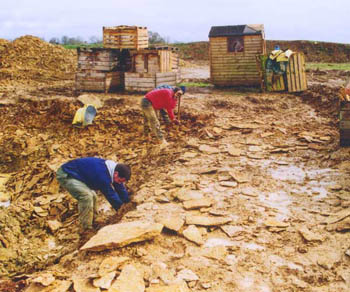|
|
ENGLISH STONE FORUM |
|
.
|
Home
> Issues > Small quarries
|
|
|
Definition
of small and large scale building and roofing stone quarries
Minerals Policy Statement 1 (MPS1) “Planning and minerals” refers to building stone quarries in terms of small and large scale operations. However it does not provide definitions of these, leaving that to the discretion of individual Mineral Planning Authorities. Making a suitable distinction for planning purposes is not straightforward because the environmental impacts associated with quarrying depend on factors such as:
The following comments are made to assist those who need to implement the policies in MPS1. |
 |
Discussion
Paragraph 99 of the Minerals Practice Guide accompanying MPS1 builds on Chapter 4 of “Planning for the supply of natural building and roofing stone in England and Wales” prepared by Capita Symonds. As a starting point, this states: “There are currently about 300 active quarries and mines in England that produce building and roofing stone, but only a few produce roofing stone. Most are very small compared with, for example, modern aggregates quarries. Ninety percent of these are intermittently worked sites that have an annual output of 2000m3 or less and many produce 100m3 or less. These commonly have only one or two employees and mainly serve local or specialist markets. However, the remaining 10% of larger sites produce on average 20,000m3 per annum and, therefore, account for about 70% of the annual production of 650,000m3 (1m3 weighs about 2.0 to 2.6 tonnes). These larger quarries may market stone on a regional, national and even international scale”.It might be appropriate therefore, as a rule of thumb, to propose that small quarries produce less than 2,000m3 of stone per annum and large sites produce more than this. |
| In
general, therefore, it is concluded that a small-scale building and roofing
stone quarry is one that produces, on the average, less than 2,000m3
of product per year. But each case must be considered on its merits.
Recommendation
|
|
| . |
|